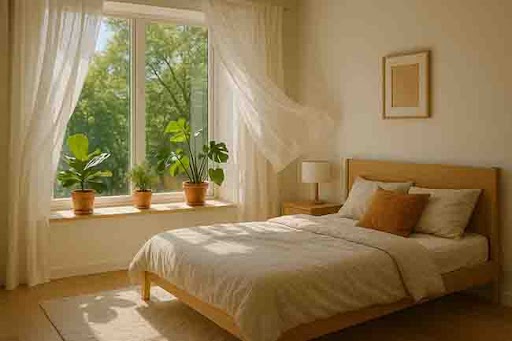Some Effective Hacks to Keep Your Home Cool Without Air Conditioning
Many homes feel hot and uncomfortable during summer. Running air conditioning all day is expensive. It also doesn’t work well in areas with frequent power cuts. There are simple ways to cool your home without using machines.
These tips focus on airflow, shade, and smart materials. You can use them in flats, houses, or even rented rooms.
Also Read : Eco-Friendly Materials for a Greener Build
How to Maintain Indoor Thermal Comfort Without Air Conditioning
Most heat comes from windows and roofs. These surfaces absorb sunlight and warm up your rooms. Block the heat at the source to lower indoor temperature.
Use thick curtains on sunny windows. Choose dark or reflective layers for better effect. Blackout curtains work well. If you don’t have those, use bed sheets or blankets.
Shut your windows during the day. Open them after sunset. This traps cooler air inside.
Let fresh air flow during early morning and late evening. Open windows on opposite sides. Cross-ventilation helps move warm air out.
Fans help more than people think. Use ceiling fans with the correct rotation. They should spin counterclockwise in summer. This pushes air downward and cools the body faster.
Place a bowl of ice or frozen water in front of a fan. The fan pushes cooler air across the room. This works in bedrooms, kitchens, or offices.
Use fans in bathrooms and kitchens too. These rooms trap a lot of heat. Exhaust fans remove warm, moist air.
Extra tips that help at night:
- Sleep with cotton bed sheets
- Use light, loose clothes
- Keep a cold water bottle near your bed
- Avoid charging devices next to your bed
Your body cools down faster in a breathable, low-heat setting.
Also Read : 6 Effective Tips for Solar Panel Maintenance
Why Passive Cooling Techniques Are Effective in Hot Climates
Passive cooling means using natural methods. These techniques have been used for centuries. Many old Indian homes were cooler even without machines.
Modern houses can follow the same ideas. First, reduce internal heat. Most people don’t realize how much heat comes from daily use.
Turn off appliances you don’t need. Unplug TVs, laptops, chargers, and kitchen gadgets. These devices give off heat even when not used.
Switch to LED bulbs. They stay cooler and use less power. Avoid using halogen lamps or decorative lighting during summer.
Avoid cooking indoors during the day. Ovens, stoves, and toasters heat up small rooms quickly. Cook in the morning or late evening. Use the microwave instead of the gas stove.
Your choice of fabric affects comfort. Avoid thick blankets, polyester sheets, or furry carpets. Cotton and linen stay cooler. Choose pale or white shades. These reflect heat instead of trapping it.
Hang a damp sheet in front of an open window. Wind passes through and feels cooler. This simple method works well in dry areas.
Take cold showers twice a day if needed. Stay hydrated. Eat more fruits and vegetables. Avoid heavy, hot meals during peak heat
Top Architectural and Material-Based Hacks to Keep Homes Naturally Cool
Building design plays a big role in indoor temperature. Certain materials store or block heat better than others.
Roofs absorb heat quickly. Paint your roof with white or reflective paint. This lowers roof surface temperature. Rooms below feel cooler.
Use insulation if you’re building or renovating. Roof insulation blocks heat from entering. It helps during both summer and winter.
Exterior walls also trap heat. Use high-reflective paint outside. Choose light colors for best results.
Avoid metal surfaces in outdoor spaces. Metal heats up and radiates warmth back into the building. Use tiles or concrete wherever possible.
Use thermal mass to your advantage. Exposed brick, stone, and cement absorb heat during the day. At night, they release it slowly. This reduces temperature swings indoors.
Try these ideas to reduce wall and window heat:
- Grow plants near windows
- Use bamboo shades or outdoor curtains
- Place potted trees on balconies or rooftops
- Build pergolas with climbing vines
Indoor plants help as well. Place snake plants, aloe vera, or peace lilies near sunlit windows. These plants cool small areas and purify the air. Grouping them makes a bigger impact.
Close off unused rooms during the day. This prevents heat from spreading. Keep the cooler spaces isolated.
Avoid thick rugs and carpets on the floor. These store heat. Use cotton mats or bare flooring during summer.
If you have a two-story home, avoid the top floor during the day. Heat rises. Lower levels are cooler.
Conclusion
Air conditioning is useful, but it’s not the only option. Your home can feel cooler with smart habits, better materials, and thoughtful airflow.
These solutions are practical. Most of them are low-cost or free. Anyone can use them. You don't need to renovate your entire home to feel a difference.
Focus on blocking sunlight. Improve ventilation. Remove sources of indoor heat. These three ideas form the base of passive cooling.
Try a few hacks this week. Use what fits your home best. Over time, the indoor climate becomes more stable.
Cool homes start with small changes. Start today, and feel the difference tomorrow.

